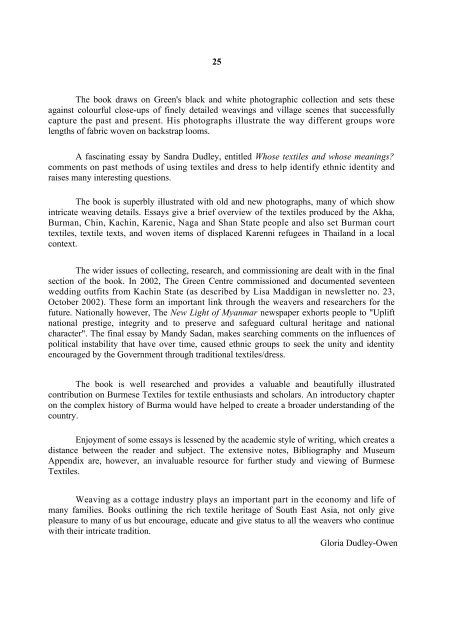download - OATG. Oxford Asian Textile Group
download - OATG. Oxford Asian Textile Group
download - OATG. Oxford Asian Textile Group
- No tags were found...
You also want an ePaper? Increase the reach of your titles
YUMPU automatically turns print PDFs into web optimized ePapers that Google loves.
25The book draws on Green's black and white photographic collection and sets theseagainst colourful close-ups of finely detailed weavings and village scenes that successfullycapture the past and present. His photographs illustrate the way different groups worelengths of fabric woven on backstrap looms.A fascinating essay by Sandra Dudley, entitled Whose textiles and whose meanings?comments on past methods of using textiles and dress to help identify ethnic identity andraises many interesting questions.The book is superbly illustrated with old and new photographs, many of which showintricate weaving details. Essays give a brief overview of the textiles produced by the Akha,Burman, Chin, Kachin, Karenic, Naga and Shan State people and also set Burman courttextiles, textile texts, and woven items of displaced Karenni refugees in Thailand in a localcontext.The wider issues of collecting, research, and commissioning are dealt with in the finalsection of the book. In 2002, The Green Centre commissioned and documented seventeenwedding outfits from Kachin State (as described by Lisa Maddigan in newsletter no. 23,October 2002). These form an important link through the weavers and researchers for thefuture. Nationally however, The New Light of Myanmar newspaper exhorts people to "Upliftnational prestige, integrity and to preserve and safeguard cultural heritage and nationalcharacter". The final essay by Mandy Sadan, makes searching comments on the influences ofpolitical instability that have over time, caused ethnic groups to seek the unity and identityencouraged by the Government through traditional textiles/dress.The book is well researched and provides a valuable and beautifully illustratedcontribution on Burmese <strong>Textile</strong>s for textile enthusiasts and scholars. An introductory chapteron the complex history of Burma would have helped to create a broader understanding of thecountry.Enjoyment of some essays is lessened by the academic style of writing, which creates adistance between the reader and subject. The extensive notes, Bibliography and MuseumAppendix are, however, an invaluable resource for further study and viewing of Burmese<strong>Textile</strong>s.Weaving as a cottage industry plays an important part in the economy and life ofmany families. Books outlining the rich textile heritage of South East Asia, not only givepleasure to many of us but encourage, educate and give status to all the weavers who continuewith their intricate tradition.Gloria Dudley-Owen
















